I made a thing! Right now my life is a sea of toiles for the next Scroop + Virgil’s pattern, and it seems like I will never get to sew anything that isn’t calico (that’s muslin for those in the US).
So it’s doubly exciting to have taken a little time to make something not-toile, and in such scrumptious fabric too.
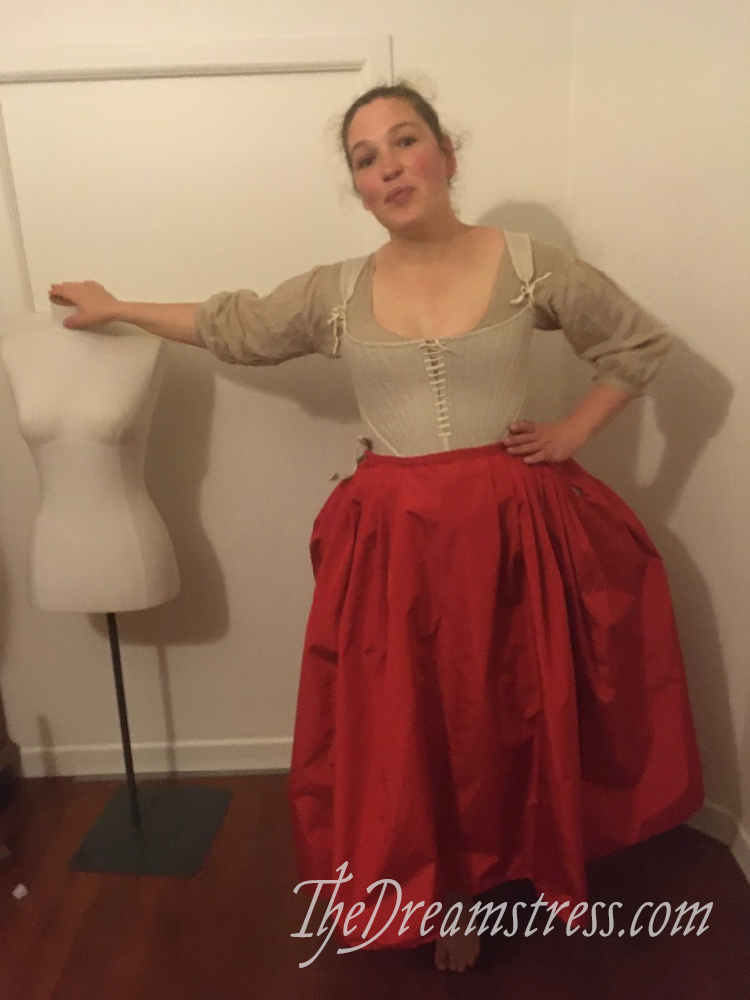
I have some 1780s sewing (to go over the Scroop & Virgil’s Augusta Stays of course!) planned for this year, and I looked at all my fabrics, and realised that what they all had in common was that they would look great with a red petticoat.
I had no suitable red in stash, but when I was shopping for fabrics for the Robin Dress samples I let myself linger in The Fabric Stores silk section (always a dangerous activity) and they had an amazing silk-cotton faille in bright red.
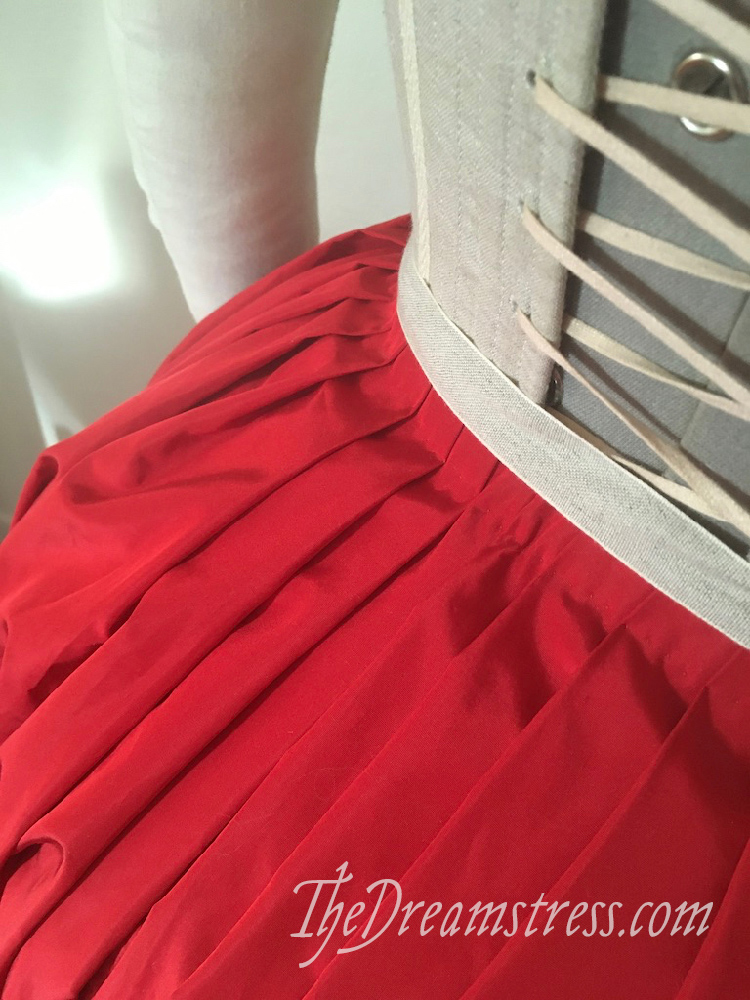
I wanted a dark red, but the fabric was so scrumptious, and such a perfect match to the weight and hand of one of the 18thc dresses I’ve been able to handle in person, that I couldn’t resist. And it was on sale…
I experimented with dyeing it a darker shade, but it changed the fabrics hand, so I decided bright red would do.
The petticoat wasn’t top of my to-do list, but just as I wrapped up the Robin Dress launch, and was feeling like I deserved a sewing treat, Burnley & Trowbridge launched their petticoat sew-along on YouTube. Kismet!
Now, confession time:
I don’t watch YouTube.
Not ever.
OK, not entirely true. I try. People rave about the YouTube costumers, and I’ve tried them. But even when I’ve met them and love them in person, I hate the YouTube format. I just turn into some horrible curmudgeon shouting “why did that take you 11 minutes to tell me! I could have read it in 37 seconds”, and “Oh my god, why are you being cutesy! You’re a professional adult” and “6 minutes of intro for 2 minutes of actual info!” and “Why do so many things pop up! Does every bit of information need an amusing arrow or caption to accompany it!?!” at the screen.
Videos just aren’t how I like to learn and relax. There’s so much noise in the world, and YouTube is just more noise which stresses my brain (I have exactly the same reaction to most podcasts).
So I keep reading blogs, because blogs make me happy and enthusiastic, and I like being a happy enthusiastic person, not the guy from Up at the start of the movie.
But, with the lockdown on, I guess I was getting so much silence that for once my brain had space to appreciate some extra talking. And I enjoyed the B&T series! (OK, I may have yelled at it for being cutesy at least once…). And it helped me to make what is definitely the prettiest petticoat I’ve ever constructed.
First I sewed the side seams. I happened to have exactly the right shade of red silk thread in stash. More kismet!
Then I hemmed. So much hemming…

Then I hemmed the pocket slits. Because of the width of my fabric they weren’t on seams, so I had to slash them into the fabric. I really don’t want them to rip out at the bottom, so I worked little reinforcing circles of buttonhole stitches.
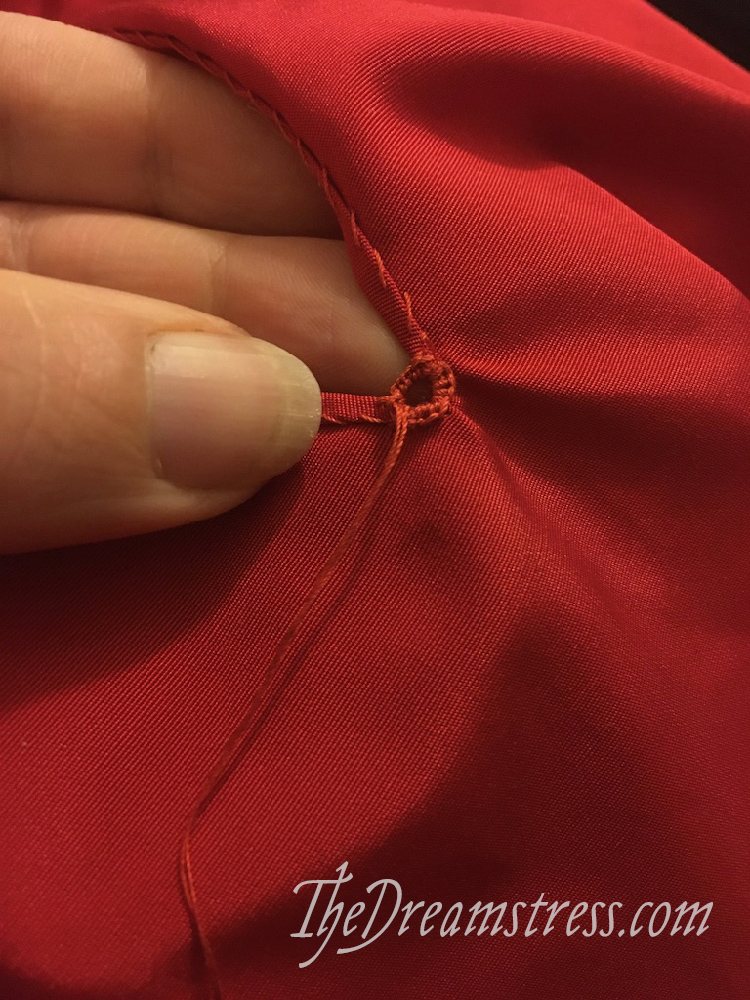
I have zero evidence that these are accurate to the period (in fact, I’m pretty sure they aren’t) but they are pretty, and will do the job extremely well.

Then it was on to pleating. I took me 8 tries to get it just right…
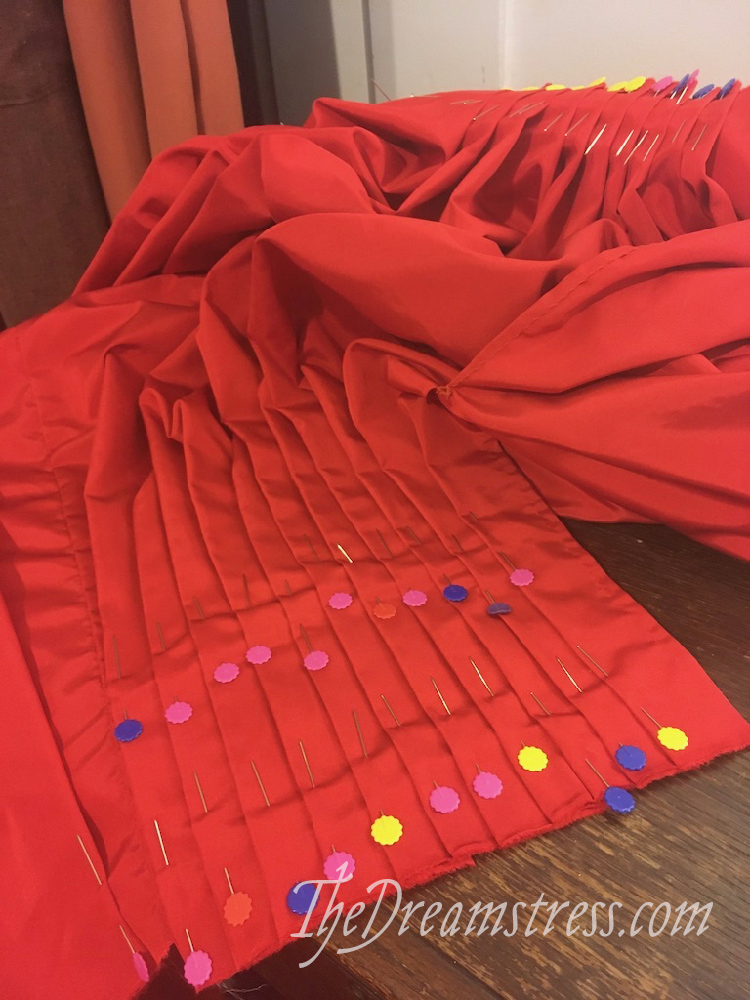
I did two lines of diagonal basting to hold the pleats in place:
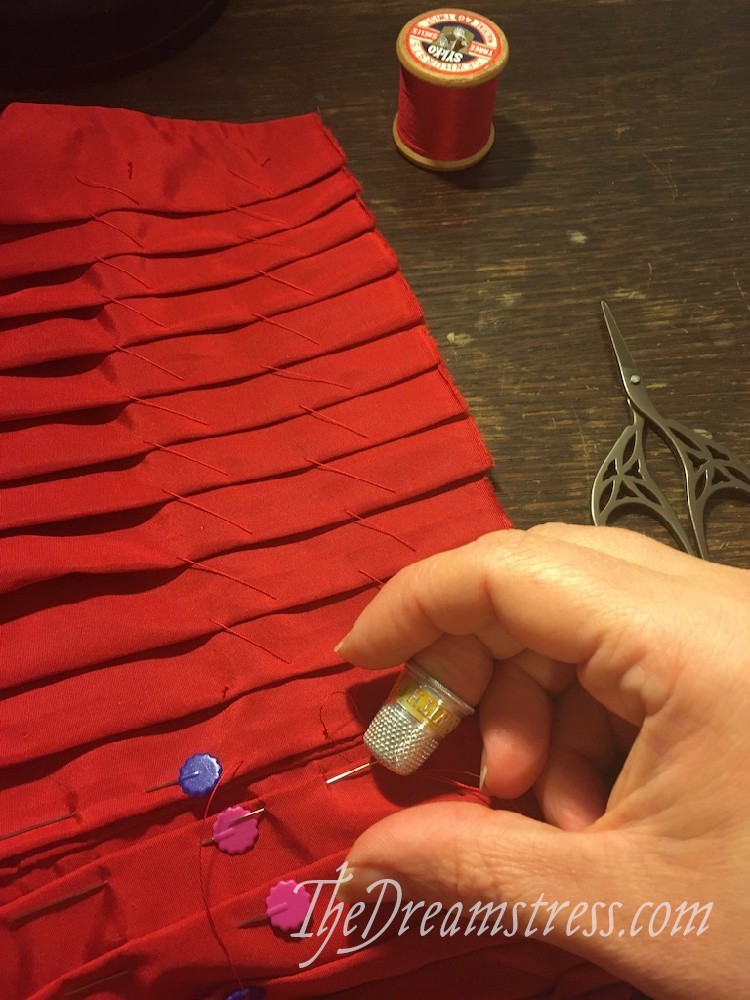
And then blanket stitched the top, because I love a good line of blanket stitching.
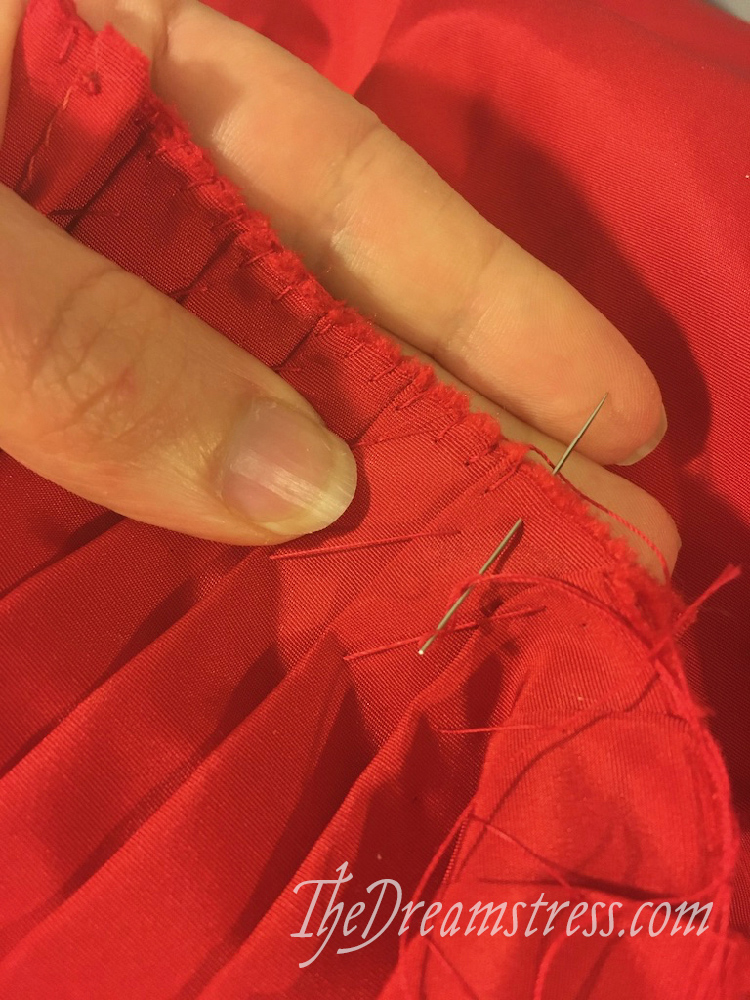
Then it was on to levelling the hem! The American Duchess Guide to 18th c Costuming has a great discussion on how to do this.
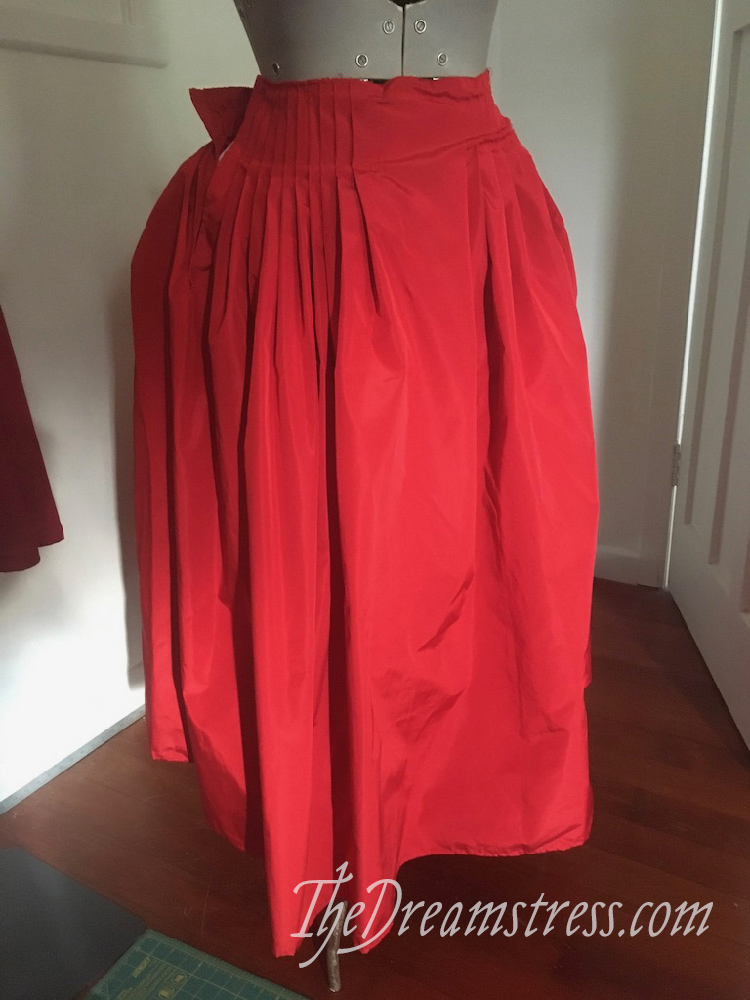
What I did is a little different to the AD book, because I levelled mine over a ‘croissant’ rump (like the ones shown on the woman on the far right or the kind just above the head of the man in the red jacket), rather than a split rump, although the general principal is exactly the same.
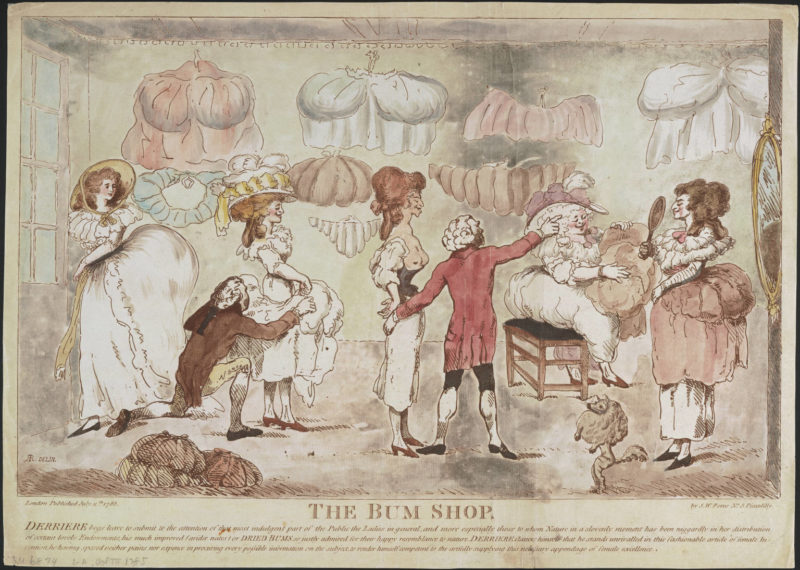
I levelled over a croissant rump because I want to wear it with a jacket that will sit best over a croissant rump, and if I’d levelled it over a split rump it would end up with a funny dip in the hem when worn with a croissant rump. If I do want to wear it over a split rump I’d be wearing it over an Italian gown, where the skirts of the gown will hide any irregularities in the back hem.
I hemmed it at 8.5″ off the ground on me, which is more in line with 1770s and early 1780s fashion than later 1780s fashion, when the skirts usually get longer (although there are some examples that still show exposed ankles I haven’t done a proper survey of what types of outfits show shorter skirts, and what types show longer)
If I want a longer skirt later, I may add a piece and hide it with a strip of contrast ribbon, similar to what is shown in this plate.
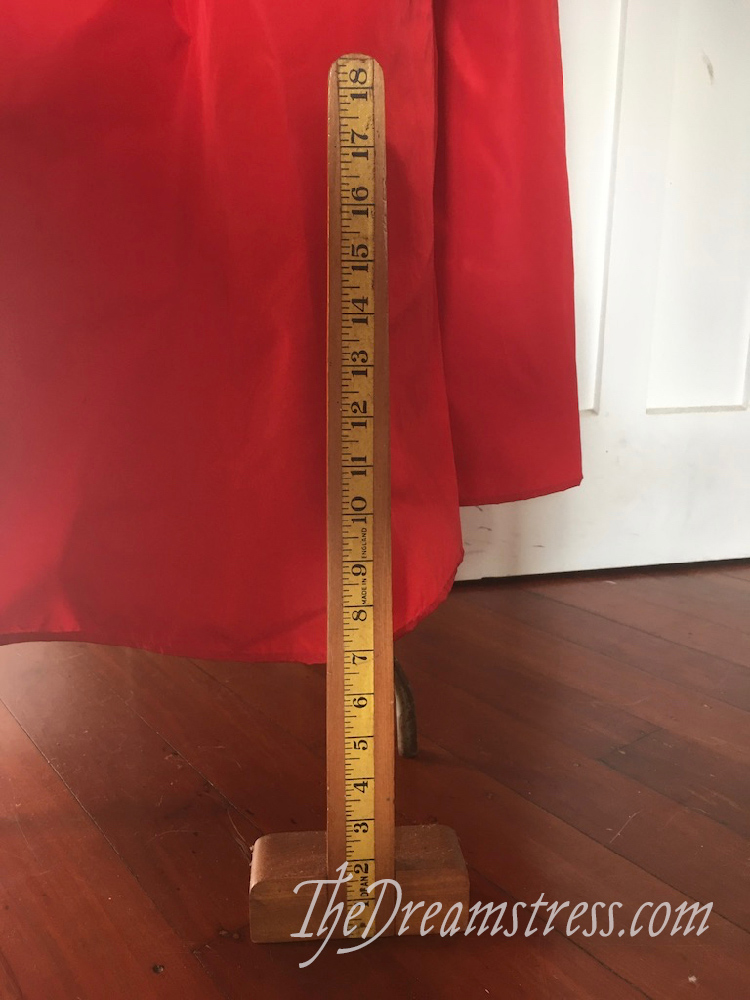
With the hem levelled, it was on to sewing on the waistband, with assistance from Miss Felicity:

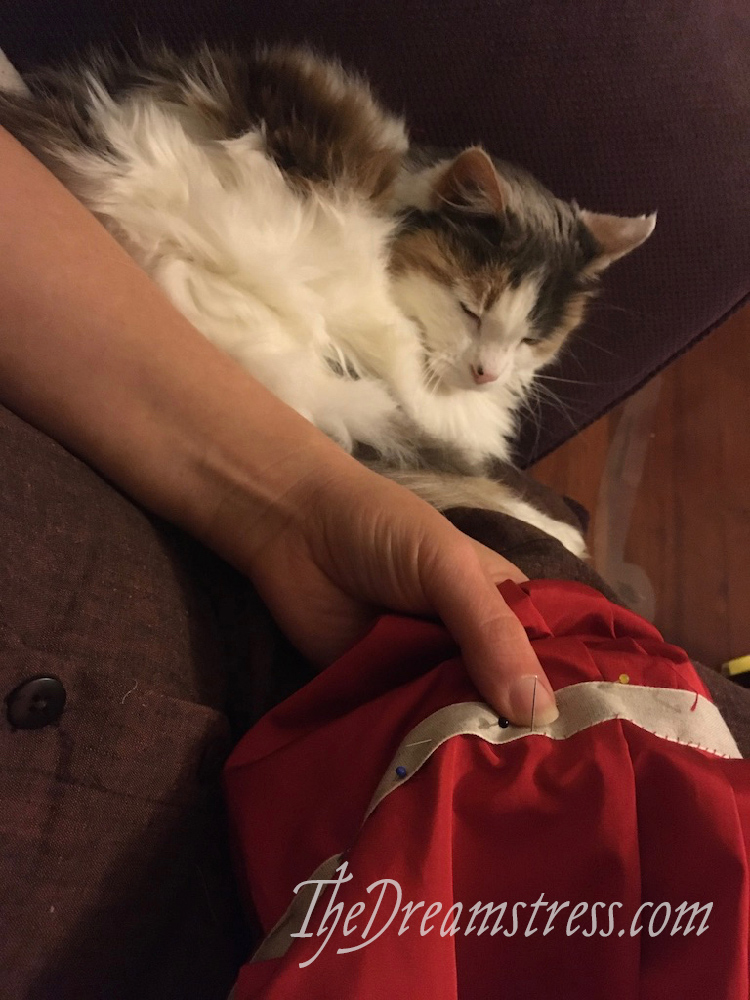
Almost there…

And the final touch was hemming the tapes:
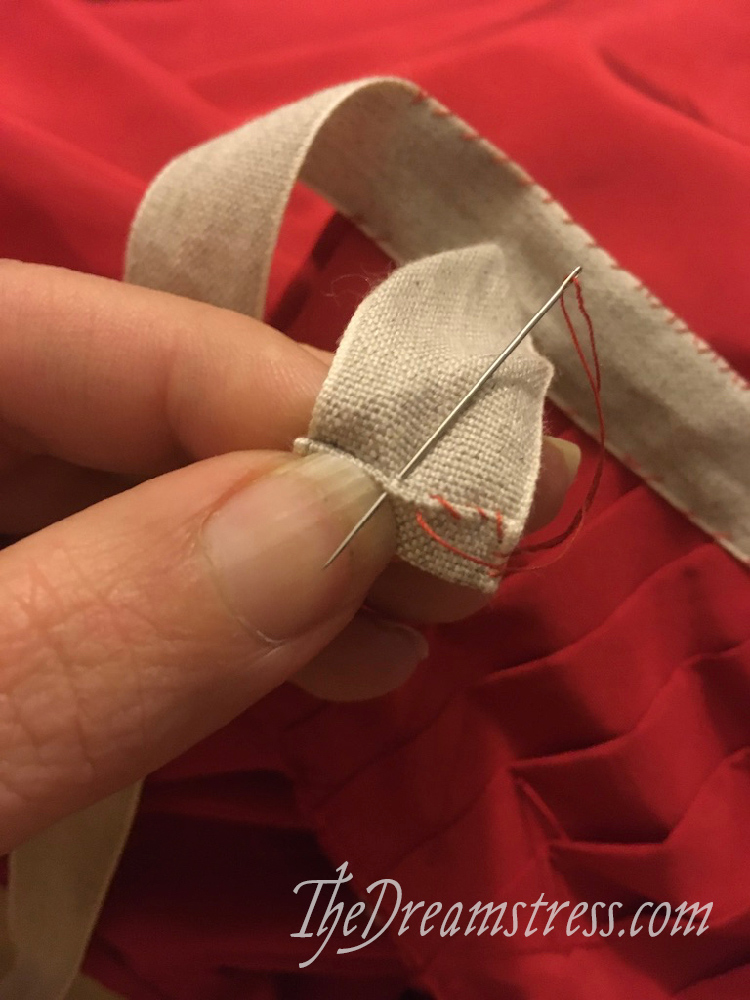
Done!
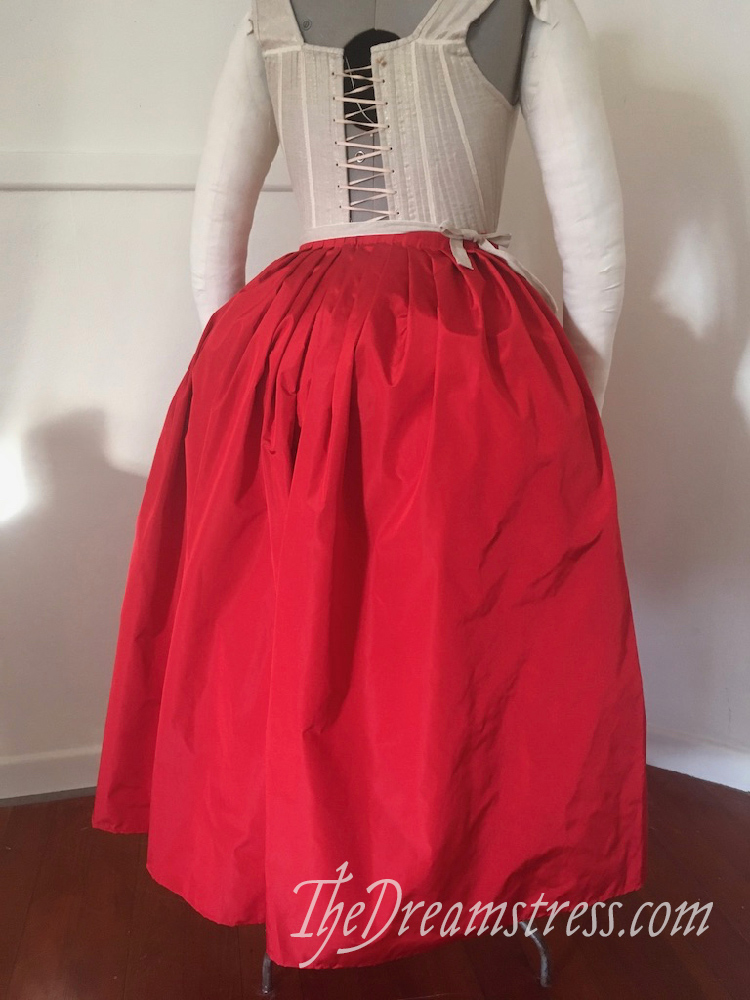
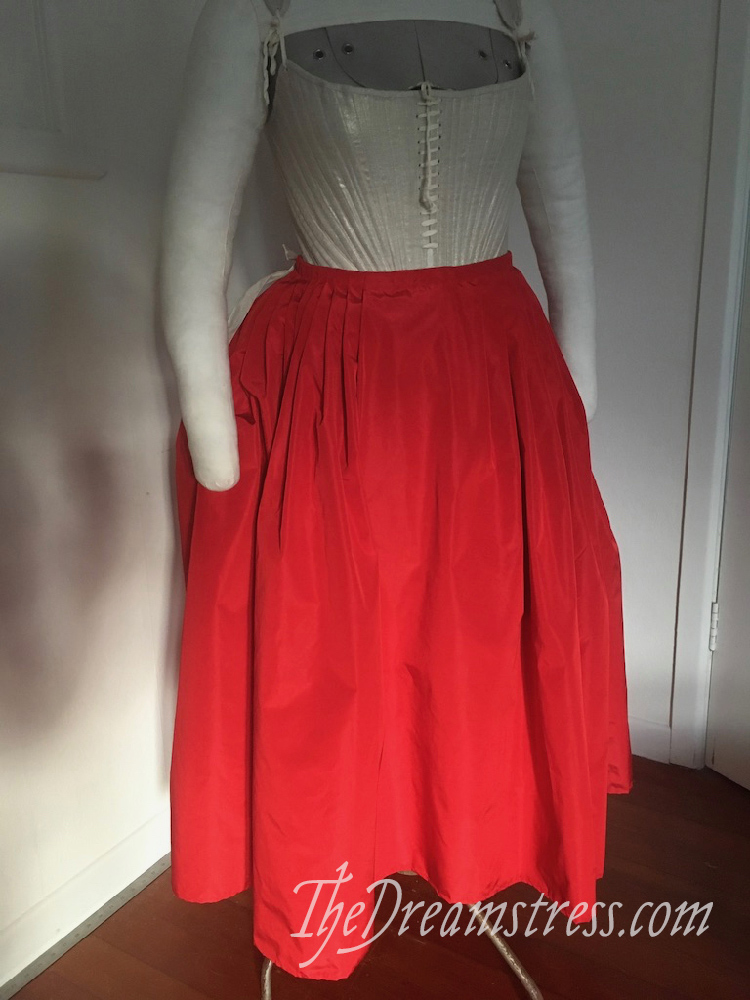
And, since it has pocket [slits] I had to make Gertrude stick her hands in them!
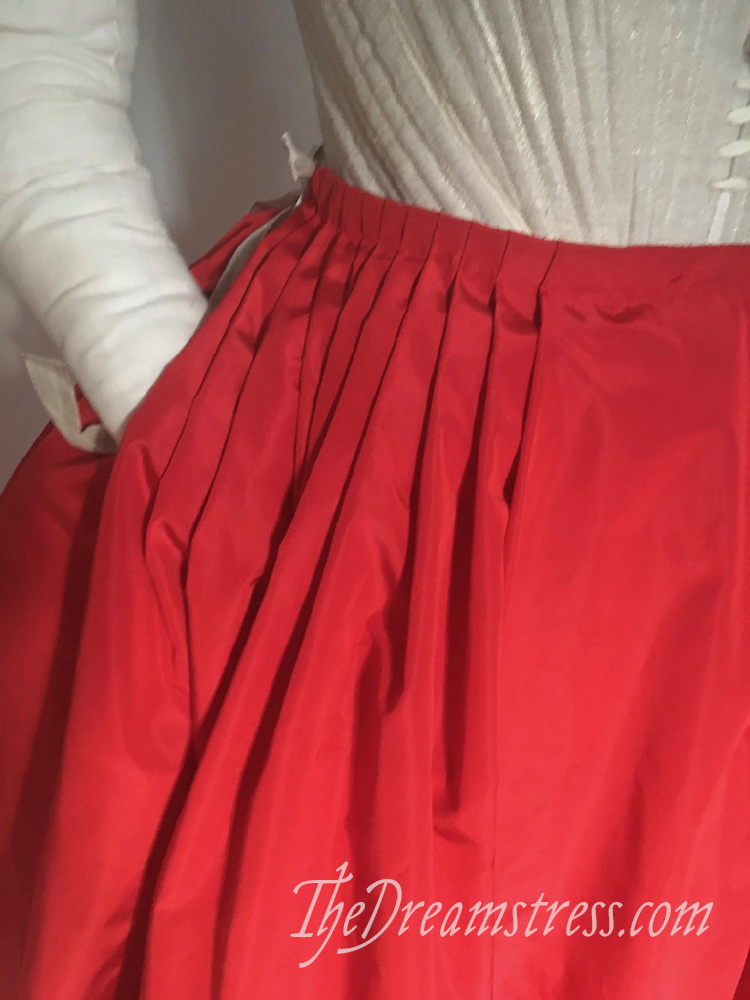
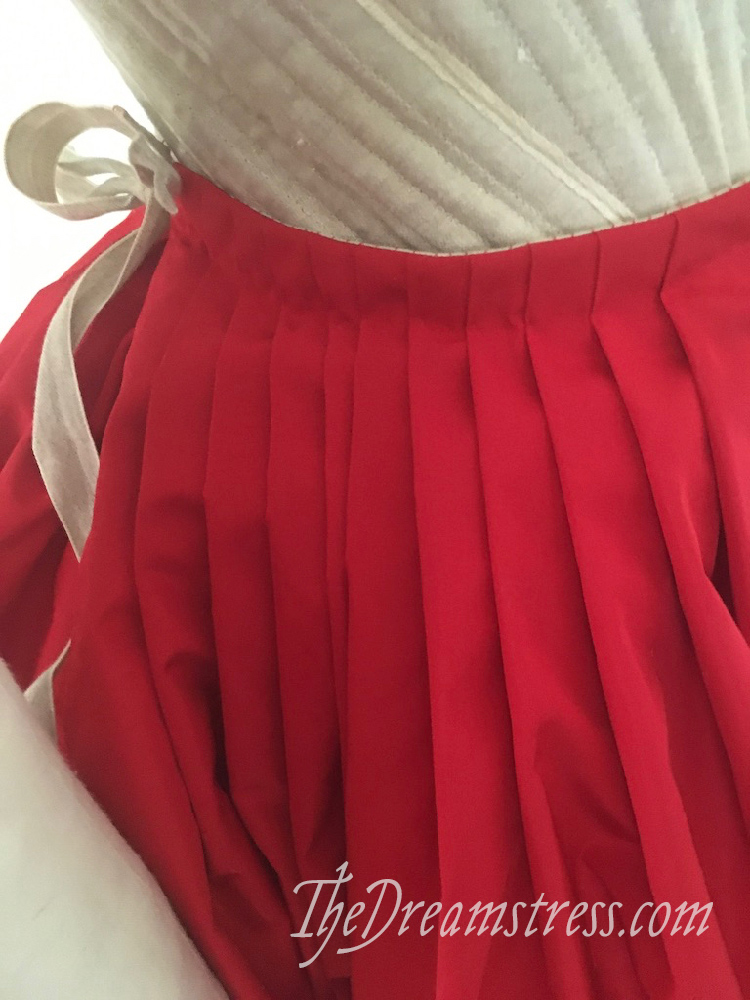
There’s even photos of me in it!

Although with my frizzy hair and bare feet I do look more like a hobbit than an elegant 18th century lady…
And I’m submitting it for the Historical Sew Monthly 2020 Challenge #12: Community
What the item is: A petticoat
How it fits the challenge: The Burnley & Trowbridge sew-alongs are a wonderful example of the historical costuming community’s generosity, and they way costumers come together in times of stress to support each other. Angela has been a fabulous cheerleader and mentor, and I’m so grateful to be part of her community.
Material: Ribbed silk cotton
Pattern: None, based primarily on the Burnley & Trowbridge petticoat sew-along, with reference to the AD 18th c Dressmaking book and period sources.
Year: ca. 1780, but wearable for 1770-1790
Notions: silk thread, linen tape from Burnley & Trowbridge
How historically accurate is it? The fabric is an excellent match to the weight and hand of an 18th c dress I’ve examined, but I haven’t been able to document examples with a silk cotton blend. Extant 18th c silks seem to be a slightly pinker red than this. The pocket-slit reinforcement was probably not used in the 18th c.
Hours to complete: about 8
First worn: Only for photos.
Total cost: About NZ$50
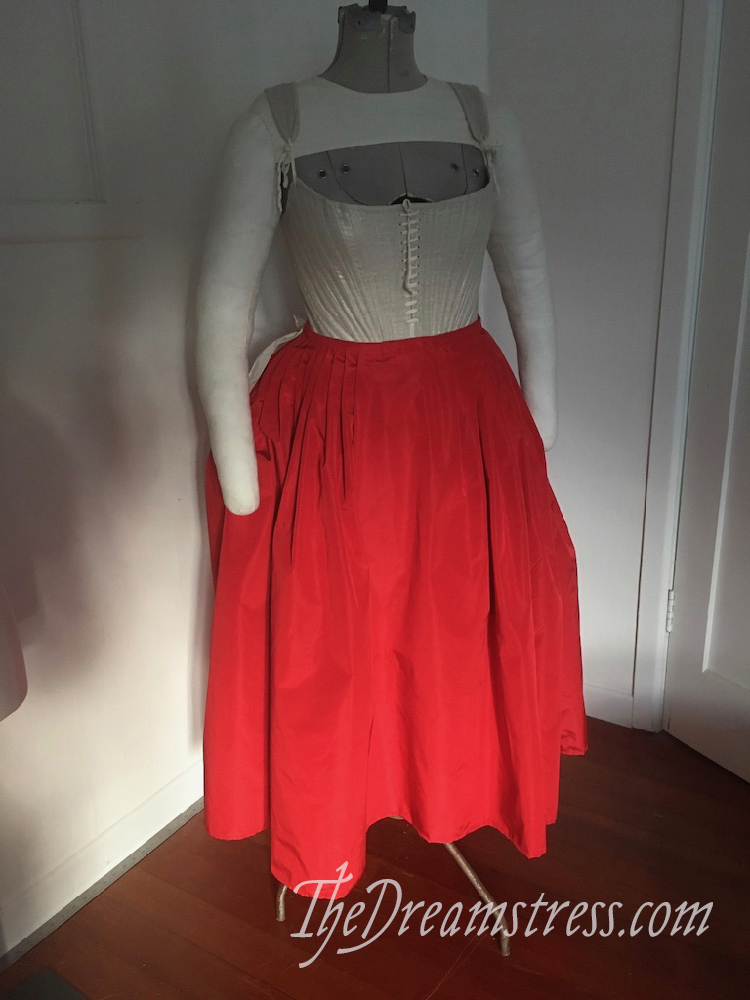

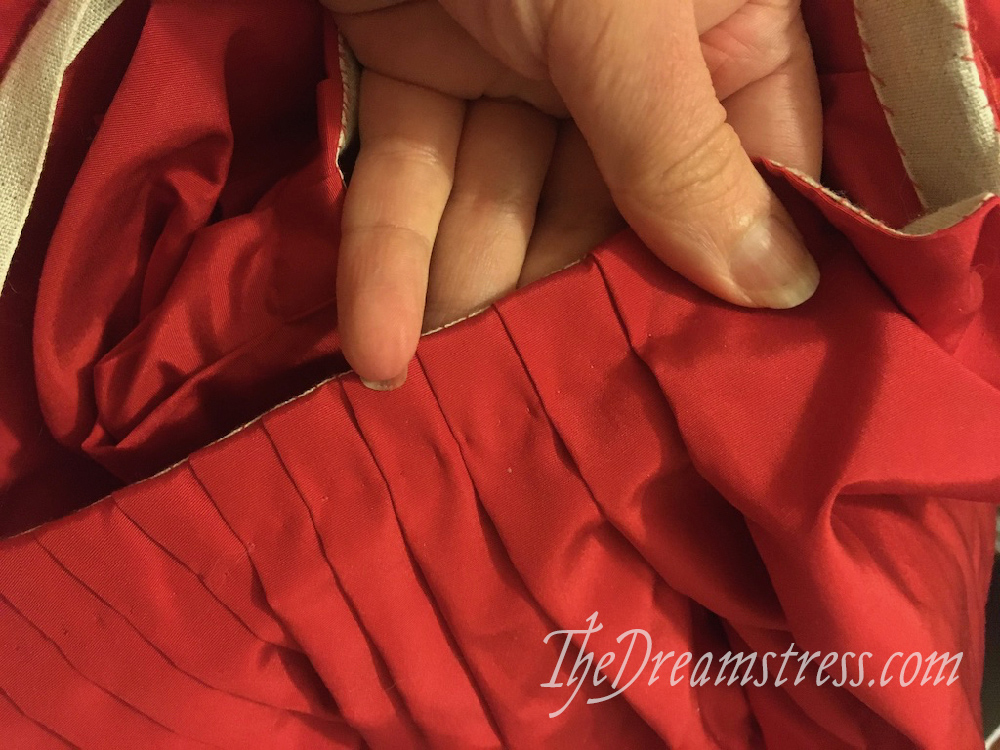
That’s such a fabulous fabric and such a fabulous petticoat.
And oh my goodness, more things we have in common!
1) I do watch specific YouTubers these days, but largely because I’m a very visual person so I do enjoy seeing how things work in motion etc., and sometimes I pick up little tricks they just do and don’t even mention. (Also I do enjoy Bernadette Banner’s specific sarcastic brand of humour, great focus on historical accuracy / period techniques, and nice calming aesthetic – so it usually does lift my spirit to watch her videos and I kind of get more from them than just the sewing. Even then, the occasional 45 or so minutes of largely talking is definitely excessive in my book.) But yes, all the unnecessary talking so many YouTubers do! Ugh! Basically I don’t really follow any other Costubers and only follow very tutorial-focused sewing YouTubers otherwise. Can’t listen to podcasts, either! Whenever I try, I back out the moment they start just chatting and not talking to the point! It’s been puzzling me because I do enjoy the (very) occasional radio programme… and then I realised radio programmes usually are far more to the point.
2) Blanket stitch! Yesss! Guess what I’m finishing the seam allowances of my Ngaio-in-progress with? 😉
At first, I thought the word “Costubers” was a typo, then I understood the portmanteau. Oh, that is a neat term.
Like most others, here, I prefer to read (and scan) than to watch YouTube. But I do appreciate that the generation under me prefers videos, and there is no replacing watching movement in real time.
I wonder if blogs will become more “curated” and intentional in their audiences. If books survived television, then surely blogs will survive YouTube.
I picked it up from Bernadette Banner and I think a couple connected videos from people I don’t normally follow… It’s apparently a Thing these days.
Beautiful , wish l could buy that fabric, but the postage to England would be terrifying. I have a bit of a thing about blanket stitch too, l like to use it for finishing hems and applique but l wouldn’t be suprised if pocket slits weren’t finished that way in the 18th century too, as it makes sense. With the pockets in constant use the pocket slits would take a lot of wear and tear so reinforcing them like this would stop the fabric tearing
Felicity as always is a bonus
I’m the same way with YouTube and videos. I tend to look for the playback speed button and advance the speed to 1.5 and sometimes 2.0. and use my mouse to skip ahead. I also put on the close captioning if it is available. Because of hearing aids I never listen to podcasts as I miss too much (no close captioning). Good suggestion on the pockets with the buttonhole stitch. Love the petticoat color.
i so agree about the youtube thing. i cannot love it. yet i cannot wholly do without it, either…sometimes one simply needs to see something executed to know what is meant in the directions.
i am green with envy over your lovely scarlet petticoat! i’ve longed for a red silk petti forever, it seems. and as always, your stitchery is perfection.
Ooh what a rich colour! I can only imagine how nice the fabric must be to handle; I’ve never encountered any silk-cotton blend other than voile.
It’s interesting about YouTube–I didn’t grow up in a home that had TV or radio in the background, but when I moved out and lived alone, I found I had a greater need for more noise, whether it was music or YouTube or whatever, especially while doing my least favourite chores. Now that I’m isolated with four other adults, I find I’m much less interested!
I’ve noticed that more and more clothing is blending silk with cotton, or silk with linen. Maybe one day, when we are able to leave the house, it will be possible to visit a clothing store.
The color really is pretty, isn’t it?
Reminds me of Gone with the Wind and Mammy’s red petticoat…
You’re sewing so well, it’s such a good work !
That’s exactly what I thought! Does it rustle when you walk? I am totally stealing your buttonhole circle pocket reinforcements. How practical, yet aesthetically pleasing.
I’m not familiar with the reference, and am pretty uncomfortable with using Gone with the Wind as the touchpoint for all historical costumes. Gone with the Wind promotes a romanticised and glamorised revisionist history which whitewashes the horrors of slavery and the goals and complicity of the Confederacy.
I’m somewhere in the middle regarding watching YouTube videos. I have been known to watch some of them at 1.5 or even 2 times normal speed. I am not interested in watching people sew seam after seam on their sewing machine. I really do prefer blogs and photos. I enrolled in Craftsy to watch their instructional videos and those are a bit better.
I like to listen to podcasts while I machine sew but I don’t listen to many of them. I do like to watch things like Ruth Goodman BBC Victorian Farm while I crochet or hand sew but that’s not the same thing.
The red petticoat is glorious.
Oops, looks like I started a trend of people commenting on something else than the petticoat! I didn’t expect so many people sharing our spoken word predilection! 😀
Incidentally I’m also slightly envious of your faille. That’s not a type of fabric I see much of around here…
sartor.cz… although now I’ve noticed Sartor has just that sort of blend. Just not in such a colour!
https://www.sartor.cz/5886-ryps-jemny-kremovy.html
This one was 80% silk, 20% cotton, which is why it retains such a sheen, I think.
What a joyously voluminous petticoat! Red is a great colour for petticoats, in my opinion – there’s just something psychologically satisfying about the warmth of the colour.
I tend to absorb things visually (you know what they say about in one ear and out the other), but I’m still not that keen on YouTube tutorials. I prefer photo-tutorials when I can find them. They don’t move so fast, and I can scan rapidly through any excess verbiage!
I also very much prefer to read than watch tutorials! It’s why I love this blog, and why I try to keep my own blog alive, for other costumers that want to decide their own tempo when it comes to taking in information.
That’s a gorgeous petticoat, and beautiful stitching. I share many of your frustrations about youtube videos, although there are some I have enjoyed. I particularly liked Rachel Maksy’s recent one about not being born in the wrong era, and all the thoughtful comments from other costumers.
It’s magnificent and I’m excited to see the things you sew to go with it! 1780’s fashion is such fun! The little buttonhole stitch bits at the slits look a lot like the ones on some 18th century mens shirt slits, so I think it’s a perfectly reasonable period solution.
I quite like historical sewing youtube videos, but I’m a bit picky about pacing, and don’t like to watch really slow ones that make me go “Oh my god why would you cut your footage like That, you could have easily made this SO much more streamlined”. I like listening to the ones with talking while I hand sew, because it’s nice to sew a thing when someone else is also sewing a thing. And perhaps because I recently moved from a house of 6 to an apartment with just one quiet roommate, and am used to a lot of talking & noise. But we all have different tastes! (And I would like to try making videos of some sewing projects, but I will still blog about the construction just as thoroughly as before. Sewing blogs are good and we must not let them die.)
Hurrah for red petticoat and making a thing! So pretty and scrumptious.
I like reading blogs and tutorials, too. At least, the B & T ones can easily forward through the long intro.
“why did that take you 11 minutes to tell me! I could have read it in 37 seconds”
Exactly my thoughts!
The reinforcement at the bottom of the pocket slits is such a good idea, I would never have thought about it.
It will look marvelous with your yellow pet en l’air. Brava.
I don’t care much for getting information from videos myself, unless I need a step-by-step and image-by-image guide. And remember, it’s possible to fast forward through parts of videos that aren’t interesting (I do this myself) or, for many of them, to turn on CC (closed captioning) in your mother tongue (that helps you to figure out more easily what to skip).